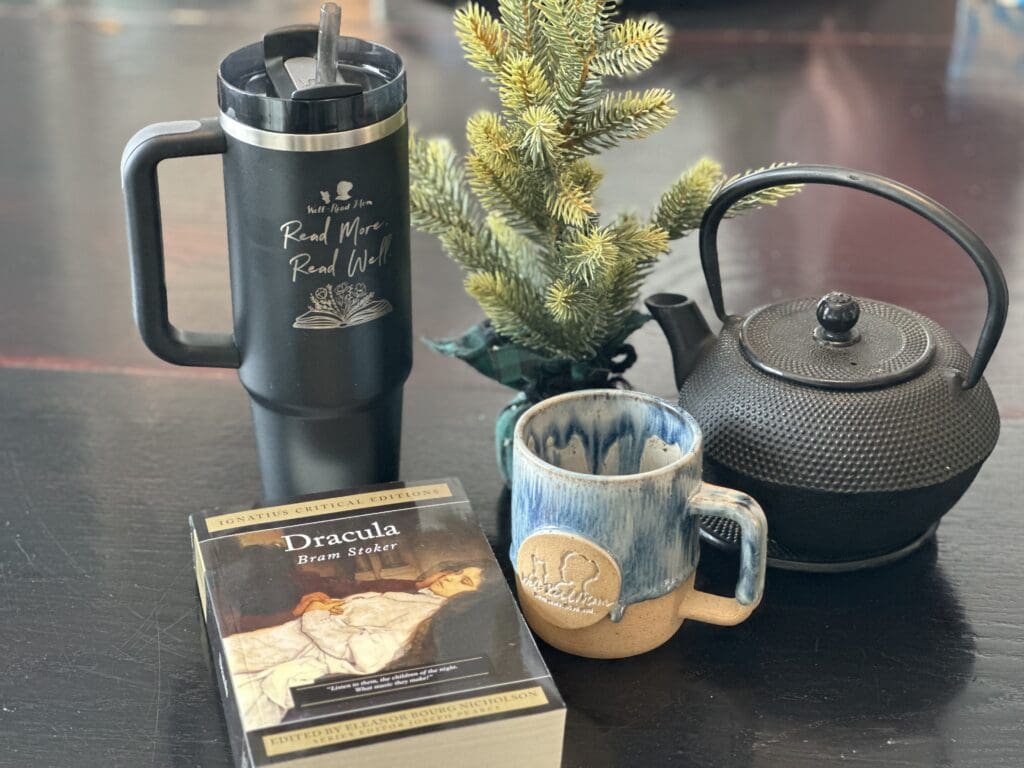Dracula: The Inspiring Power of Tangible Beauty
By Megan Keyser
Dracula has long-been one of my favorite works of fiction. I still vividly recall reading the novel as a young teenager, horrified and chilled to the core by various scenes: the piteousness of a mother begging Count Dracula to return her stolen child from his monstrous clutches; the terror-filled moments Jonathan Harker endures while imprisoned in Castle Dracula; and most disturbing to my mind, the spine-chilling voyage of the Demeter. Bram Stoker’s ability to induce fear, apprehension, and mystery in the hearts of his audience, without resorting to utter gore, was masterful, and I felt my youthful excitement brimming as I eagerly raced through the novel to its dramatic conclusion.
Since that first reading, I have returned to Dracula numerous times -simply for the sheer enjoyment of it. And while each reading stirs the same sentiments of terror in my heart, as I mature as a woman and reader, I am struck by the deeper significance behind this haunting tale. More than a mere horror story, Dracula invites the reader to examine what is required to seek and protect the Good from the evils which are always present, though not always easily recognized or seen, in our world. What fascinates me most, particularly during this latest encounter with the novel, is Stoker’s proposition that the most potent methods of promoting the Good are also some of the most ancient and timeless.
Writing at a time when the secular and cynical forces of modernity were already deeply entrenched in much of society, and particularly in academic or elite circles, Stoker appears to question the wisdom of dismissing the rituals, conventions, and beliefs of old in favor of purely “scientific” or rational thought. Throughout the novel, it is not science which offers the protagonists a way forward in combating Count Dracula, but elements of cherished folklore, Catholic Sacramentals, and a stalwart sense of camaraderie and self-sacrifice among men of good will which ultimately save the day. While trapped in Castle Dracula and facing the terrors of that dreaded place, the items that extend Jonathan Harker the greatest comfort are, ironically, simple, uncomplicated things: an unadorned wooden Crucifix; pungent garlic; wild rose; mountain ash.

While Stroker clearly uses his imagination and legendary folklore in choosing these items as most effective in vampiric combat, is there an undercurrent of truth found here? Harker himself wonders about the Crucifix:
“It is odd that a thing which I have been taught to regard with disfavour and as idolatrous should in a time of loneliness and trouble be of help. Is it that there is something in the essence of the thing itself or that it is a medium, a tangible help, in conveying memories of sympathy and comfort?” (Page 52).
What is it about sacred images and what they signify that bring solace to the weary, and hope to the fearful or despairing? Do tangible and beautiful reminders of the Divine elevate our hearts in such a way as to bolster us in times of heartache or trouble?
Humans are unique: neither completely spiritual like angels, nor purely physical as other creatures, but a singular combination of both rational soul and physical body. Subsequently, it stands to reason that our spiritual needs are as firmly rooted in the physical as our souls are linked to our bodies. Hence, human beings crave and, in fact, require the tangible, concrete comforts of human existence – be that a warming bowl of stew, a comforting embrace, a flower’s sweet fragrance, or a vision of stately beauty. For centuries, Western culture, particularly in architecture and the fine arts, focused on beauty and majesty over strictly utilitarian designs, and I think it’s important to ponder why they did so.
We currently live in a society where many churches look quite like office buildings or large auditoriums, yet our ancestors crafted and worshipped within edifices comprised of incense-filled narthexes and marked by Gothic arches and spires, all of which redirected distracted human gazes to the heavens above. Why did they spend so much time, focus, and treasure on crafting these sacred spaces? For all our contemporary utilitarian focus, with smart devices and efficient machines and precise tools, do we possess the same inner peace and purposefulness our predecessors enjoyed?
Where is a person more likely to encounter serenity or enkindle the moral imagination which spurs him on to seek the Good: in a sterile office building, or an ancient and transcendent chapel? I have only had the privilege of traveling abroad to Europe on three occasions, but it struck me each time that, on any given street, in any given European city, it seems one can find a church of incomparable beauty – whether grandly ornate or austerely picturesque – in which tourists are eagerly taking pictures. How often do we see a similar appreciation or enthusiasm for the typical modern American church? Why are we often left uninspired by modernity?
While we might not require a fistful of garlic to vanquish legions of the Un-Dead, we, in a largely godless and spiritually bereft culture, do need an influx of inspiration and heavenly energy so as not to shrink away from dark, diabolical threats, but to serve God and our fellows with renewed fervor, being “willing to peril even our own souls for the safety of one we love – for the good of mankind, and for the honour and glory of God” (424). If men’s zeal for upholding what is both good and true is motivated by what is beautiful, our devotion to brilliant literature and superb thoughts can be a catalyst, however seemingly insignificant, for profound good. This devotion to the beautiful is only magnified when shared within the fellowship of friends possessing a common vision of virtue.
Perhaps in our humble, yet ardent, book-discussion gatherings, in which we congregate to delight in new thoughts and insights, while savoring creature comforts of food and drink together, we are accomplishing so very much – more than can initially be seen or recognized. We need, like the small band of vampire-fighting crusaders, to imitate the Count’s relentless energy, but to use that energy, not to promote or permit evil, but to vanquish it, and we will do this best if we are sustained by great thoughts, inspiring friends, and even a comforting mug of warm cider:
“Oh, if such an one was to come from God, and not the Devil, what a force for good might he not be in this old world of ours” (424).
Let us gather together and be inspired. Let us be such a force. Read more. Read well.
In Well-Read Mom, women read more and read well. Our hope is to deepen the awareness of meaning hidden in each woman’s daily life, elevate the cultural conversation, and revitalize reading literature from books. If you would like to have us help you select worthy reading material, we invite you to join and read along with us. We are better together! For information on how to start or join a Well-Read Mom group visit our website wellreadmom.com

Megan Keyser
Originally hailing from Pittsburgh, Pennsylvania, Megan is a 2006 Hillsdale College graduate with a degree in Classical Studies. These days, Megan thrives on the challenges and joys of her role as a Catholic, stay-at-home mother, who heads a chapter of the Well-Read Mom, dabbles in social commentary and other writing pursuits, and advocates for the pro-life cause. Despite the inevitable chaos of large family life, Megan is thankful for her lively brood and relishes juggling household responsibilities, babies in diapers, and, of course, a good book. She resides in Noblesville, Indiana, with her husband, Marc, an engineer in the energy industry, and their ten children: five sons and five daughters, ages 15 years to 6 months old.
Check out some of our other Well-Read Mom blog posts.
- Friends and the Formation of the HeartBut how do we find these friends? And, just as importantly, how do we become such friends? Obviously, a strong sense of virtue is paramount to genuine friendship, but if we are to help each other continually grow in grace and goodness, we should ideally possess clear insight and understanding, as well—particularly insight into our human nature, its foibles, and its strengths. And what better way to examine human nature, to truly consider events and people, than through the study of literature.
- Lessons in Hope from a Jane Austen HeroineIf we’re open to learning from her, Anne Elliot offers lessons of traveling in hope that apply to all of us, whether our Christian pilgrimage today includes hoping for the kingdom of heaven or hoping for a faster grocery line.

